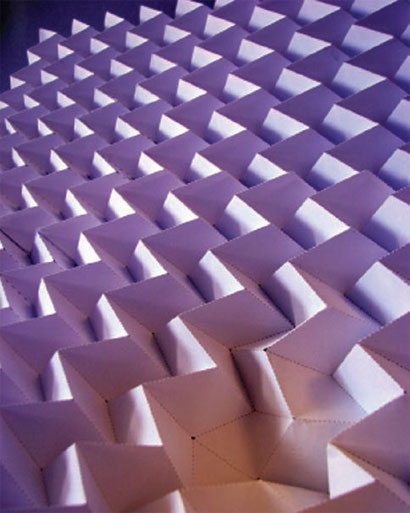For the most part, professor Itai Cohen’s physics lab in the basement of Clark Hall looks like any other. The tables are covered in computers, calculators, and. . . intricately folded sheets of paper? Cohen’s team has been studying ways to apply the Japanese art of origami to manipulate the physical properties of materials—work that has potential applications in robotics, medicine, engineering, and more.

Paper chase: The miura-ori fold in action.
The fold that Cohen’s lab has been working with is called the miura-ori. Invented by Japanese astrophysicist Koryo Miura in the mid-Nineties, it comprises a grid of alternating mountains and valleys that can be collapsed into a small, compact shape with a single motion, like an accordion. The lab’s research—spearheaded by former grad student Jesse Silverberg, PhD ’14—centers around the idea that the miura-ori is a “metamaterial,” which means that its mechanical properties derive not from the composition of the material but from the arrangement of the fold. “We can add ‘defects’ to the fold pattern, where we take a valley and turn it into a mountain,” Cohen explains. “By pushing one of the vertices through to the other side, the whole paper becomes much stiffer. So we can put these defects in different spots to ‘program’ the stiffness of the paper.”
The project—a collaboration with a team at UMass, Amherst— began three years ago when the National Science Foundation called for proposals for origami-inspired science. The Cohen group focused on the miura-ori due in part to its origins; it was invented as a way to efficiently pack solar panels for space missions. (The pattern is also seen in nature, in the developing intestines of human embryos and in the unfurling of leaf buds.) “The beautiful part about it is that the disorder—that defect that you introduce—is completely reversible,” Silverberg notes. “You put it in and the miura-ori becomes stiff, you take it out and it becomes soft.” He recalls with a laugh the meeting where the group had its “aha” moment: “We’re sitting there popping these defects in and out, making all these interesting observations on the fly. Imagine a bunch of physics, math, and science geeks staring at paper and mumbling to themselves. It really was a scene.”
The miura-ori has a wide variety of potential applications. Silverberg imagines, for example, a snake-like robot that could search for survivors after an earthquake. The robot would crawl through the rubble, then unfold into a protective structure in which to carry the victim to the surface. Another idea—already being pursued by a company in Sweden—is a foldable exoskeleton that could be sewn into clothes, creating back and neck support for workers who stand all day. The group’s collaborators at UMass have succeeded in translating the designs to the microscale by using tiny polymer sheets that fold and unfold with temperature changes. Says Silverberg: “You look at this flat sheet under a microscope, heat it up, and all of the sudden: a folded miura-ori.”
Applying origami to technological fields is a hot topic, Silverberg says. Already, its design principles are used in solar arrays and car airbag systems; medical researchers are even exploring using origami for drug delivery. “Imagine folding a microscale box,” he says, “and the box unfolds and releases drugs when it detects a cancerous cell.”
Silverberg has been an origami enthusiast as long as he can remember, having received his first book on the subject in second grade. “I’m a tactile person,” he says. “There’s something gratifying about taking a blank sheet of paper and using your imagination and creativity to sculpt a beautiful structure just by folding it.” Last summer, he attended a conference in Japan devoted to origami science—and encountered one of the field’s superstars. “Lo and behold, who was the speaker but Professor Miura?” Silverberg marvels. “I said, ‘Can I get a selfie with you?’ And now I have the picture on my phone. How cool is that?”


